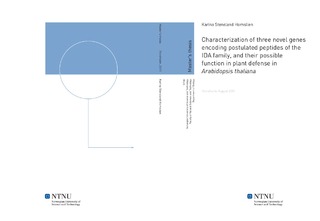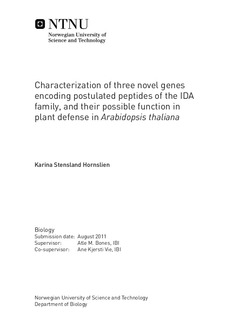| dc.description.abstract | IDL6 and IDL7 are postulated peptides of the INFLORESCENCE DEFICIENT IN ABSCISSION (IDA) peptide family in the model organism Arabidopsis thaliana. The genes encoding the postulated peptides, IDL6 and IDL7, were investigated to potentially elucidate the function of the peptides and the possible relations to plant defense and stress tolerance in A. thaliana. A phenotypic characterization study of single and double knockout mutant lines, and over-expression lines of IDL6 and IDL7 was conducted to potentially find a phenotype linked to the genes by analyzing deviations in growth and development, compared to wild type (Wt) A. thaliana. Over-expression lines showed a tendency to have a higher amount of individuals reaching defined growth stages in seedling development, but this could not be concluded to be a phenotype linked to IDL6 or IDL7.The genes have been shown to be highly up-regulated in response to several different stress treatments, both abiotic and biotic in silico data. Several different transgenic lines of A. thaliana were subjected to different types of stress treatments to potentially verify the in silico data. Knockout lines, double knockout lines, over-expression lines and promoter:GUS lines of IDL6 and IDL7 were treated with abiotic stress factors (NaCl, mannitol, UV-B light, H2O2 and paraquat) and biotic stress factors (aphids, Pseudomonas syringae and flagellin22) to investigate differences in tolerance, gene expression and promoter activity in the respective transgenic lines and Wt A. thaliana.No absolute phenotype was detected in experiments related to stress tolerance, and great variations in promoter activity using promoter:GUS lines were observed. However, double knockout mutants of idl6 and idl7 showed a small trend to tolerate NaCl better than Wt A. thaliana and other transgenic lines. The great variation in GUS expression from GUS assay lead to a thorough screening and expression analyses of promoter:GUS lines. Results presented in this work, indicate that expression of the IDL6 and IDL7 genes may be subjected to extensive post transcriptional regulation through mRNA degradation, possibly governed by stress related environmental signals. A novel member of the IDA peptide family, IDL8, was also analyzed. Segregation analyses of knock out lines were conducted and they were genotyped to verify that mutant lines of idl8 were real knockouts. Results presented here show that one of the idl8 mutant lines had the T-DNA inserted to the promoter region of the gene and is postulated to be a real knockout. However, further expression analyses should be conducted to verify that the gene is not transcribed. Over-expression lines of IDL8 were successfully constructed through recombinant DNA technology and by T-DNA insertion using Agrobacterium tumefaciens. | nb_NO |

